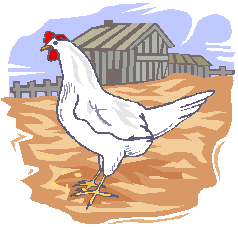

To send a message to an author, click on the author's name at the end of the article.
This Month in Ag Connection | Ag Connection - Other Issues Online
It is a common belief that poultry litter is riddled with viable weed seeds. This belief may have come from observing substantial weed growth following land application of litter. However, research from Nebraska, Virginia Tech, North Carolina State University and Auburn University has proven poultry litter, a mixture of bedding material and manure, contain no weed seeds.

In 1934, researchers in Nebraska evaluated weed seed viability in manure. They fed 1000 seeds to chickens and the results indicated chickens were efficient atdestroying weed seeds, because the digestive system of poultry, i.e. the gizzard, destroyed the weed seed. More recently, Auburn University compared broiler litter to equal rates of commercial nitrogen (N) and phosphorus (P) fertilizer. Each treatment was mixed with sterile potting soil. The treated soil was placed into greenhouse trays and half the trays were inoculated with common weed seeds while half received no weed seeds. The soil was kept moist for 6 weeks. Results showed that weeds only grew in trays where seeds had been planted, providing evidence that litter did not introduce weed seeds. It should be noted that uncovered stock piles of poultry litter can become contaminated by seeds deposited by wind or birds. However, this type of contamination is considered to be insignificant.
So, why may you observe more weeds in fields after applying poultry litter? This could be because when you are applying poultry litter you are increasing the amount of organic matter and nutrients in the soil. Germination and growth of weed seeds already present in the soil are stimulated by the higher level of fertility and the presence of organic acids in the decaying manure.
Still unconvinced? One could conduct a study at home like the one at Auburn University. Things to remember: keep the containers warm, use poultry litter that hasn't been stockpiled uncovered, use sterile potting soil, and use known viable seeds.
Submitted by: Joni Ross Harper, Agronomy Specialist
This Month in Ag Connection | Ag Connection - Other Issues Online
The era of big stockyards in the United States began with the opening of the Chicago Union Stock Yards on Christmas Day 1865. The marketing strategies represented a welcomed new beginning to a nation torn by civil war and ready for healing. Most markets operated in big cities at locations collectively called "the stockyards." The stockyards generally referred to the entire area in a city where all participants in the process, including the stockyard company, meat-packing facilities, commission agents and dealers, and railroad officials, came together to do business. A president of the Wichita Union Stock Yards once described the stockyards as a "hotel for livestock." "For instance, we rent 'em a room-a pen; if they want to eat, we feed them. We furnish branding service as a hotel furnishes a manicure; we have a veterinarian on duty, offering a complete service, just like a hotel employs a house physician." With this description in mind, this article provides a brief history of four major "livestock hotels" in Missouri.
St. Louis
During the Civil War, one of the only St. Louis industries that did not suffer was the growing meat-packing trade. Once the war ended, the need arose to build a livestock receiving and shipping center in St. Louis. However, there was no railroad bridge crossing the Mississippi to connect the east and west banks. Producers had to put their cattle on a ferry in order to reach the market. Due to available railroad access, the developers chose land to the east on the Illinois side of the river. This 400-acre site was called the St. Louis National Stockyards and was made possible with an investment of $1 million. The complex included the $150,000 Allerton House Hotel (later called National Hotel), a restaurant, warehouses, a fertilizer plant, and 5,000 pens paved with white oak planks. The stockyards opened on November 19, 1873. During the first full year of operation in 1874 the stockyards received 234,002 cattle, 498,840 hogs, 41,407 sheep, and 2,235 horses and mules. By the 1930s, St. Louis ranked second among the top terminal livestock markets in the country. However, after World War II, market declines and shifts of sales to country auctions and feedlots made livestock receipts shrink. In 1972, the yards shrunk to 100 acres with plans of a 640-acre industrial park to occupy the remaining property. At this time, the barn still handled 2 million animals per year. St. Louis National Stockyards sold its last animal in 1997.

Kansas City
During the mid-1860s five acres were mapped off for livestock trading and 11 animal pens were built but that number was quickly tripled. In 1871 officials organized the first independent stockyards company called the Kansas Stockyards Company, with the new facility constructed on 26 acres. The name was changed to Kansas City Stock Yards Company in 1876. On June 1, 1903 a huge flood ruined the exchange building and washed out a large portion of the yard. A new exchange building-the tallest in the world at the time-was built in 1911. A fire on October 16, 1917, leveled more than half the yard area, killing 11,000 cattle and 6,000 hogs. After the rebuilding and expansion, the yards covered over 200 acres and had become the largest stocker and feeder market in the world. Another fire in 1950 and a devastating flood in 1951 damaged the market extensively. A new ultramodern auction pavilion was opened on March 5, 1970, seating 500 people. However, livestock receipts at the stockyards declined to 400,000 during the 1980s. The owners auctioned their equipment and held their last sale of 150 cattle in September 1991. With that last sale, a 120-year-old "grand old terminal market" shut down.
St. Joseph
St. Joseph began in 1843 at the site of an old trading post. Citizens organized the St. Joseph Union Stock Yards during the 1870's with only 24,616 animals going through during the first year. However, by 1880, 20,592 cattle, 102,150 hogs, and 5,990 sheep had arrived. With these numbers they quickly out grew the facility. The St. Joseph Stock Yards Company opened in December 1887 on 413 acres. The St. Joseph market averaged 500,000 animals per year in the 1920s and '30s. By 1935 St. Joseph was ranked as the 8th largest cattle market in the country. During World War II receipts increased considerably; however, following the war, receipts began a slow decline. In May of 2008, operations were moved to the newly constructed Cattle Auction Barn. The St. Joseph market remains in business today.
Joplin
During the early 1930s, 42 businessmen in Joplin pooled their money and built a stockyard to create more economic activity in their community. They were hoping to attract cattle from Oklahoma, Kansas, and Arkansas. On the opening day, August 31, 1931, they indeed had cattle from all three states. The Joplin Stock Yards built a new facility on U.S. Highway 66 and U.S. Highway 71, making it accessible to the Missouri Pacific Railroad and five other rail lines. When the facility opened, it immediately became the 3rd largest livestock market in Missouri with a capacity of 9,000 animals of all types. During the first five years of business they handled over a million animals and paid over $15 million to area farmers, even during the midst of the Great Depression. In 1946 gross sales totaled $10,385,550. The stockyards received 72,658 cattle, 43,605 hogs, 25,859 sheep, and 2,933 horses and mules. In July 1995, Joplin closed its outdated facility and built new yards 15 miles away in Carthage. In 2001, the Joplin Regional Stockyards handled 498,000 animals, making it the nation's 2nd largest auction market.
The era of big stockyards in the United States began with the opening of the Chicago Union Stock Yards on Christmas Day 1865. The development of modern methods of slaughtering and freezing meat, as well as better transportation and communication technology has caused the abandonment of the century-old system. Producers are now able to market their cattle directly to feedlots and no longer need large stockyards to market their cattle. Even though auctioneers have said their last "sold" at many of the original stockyards smaller livestock hotels still remain around the country, proudly housing their guests.
Source: Heather Smith, Assistant Livestock Specialist
This Month in Ag Connection | Ag Connection - Other Issues Online
The kudzu bug, another stink bug, appears to be a faster mover than other damaging stink bugs mentioned in an previous article*. Other stink bugs, the marmorated and red banded stink bugs, are still coming but have not been moving as fast as was originally predicted. Will the kudzu bug continue to spread at its present pace? As a serious soybean pest, central Missouri farmers need to be aware of its potential damage and appearance.
Kudzu bugs are about 1/4 of an inch long, sort of oblong when viewed from above with olive-green color and brown speckles. It is beetle like in appearance with its wings being covered unlike other stink bugs. They can have several generations a year with at least two generations seen in heavily infested southern states. Some of its other names include the bean plataspid, kudzu beetle, globular stink bug and lablab bug. Some host plants include wisteria, green beans and other legumes.

The insect sucks juice from the stems of soybean plants and may reduce crop yield by as much as 30 percent. More "good" news is they are invasive in homes attracted by white or light colored walls or surfaces. They do not feed on house plants or people but can stain surfaces when crushed and their blood may be irritating to sensitive individuals. Being stink bugs, they give off an offensive odor when touched or squashed. The only positive attribute is in states or regions where kudzu is a problem weed. Kudzu bugs feed on kudzu causing injury and limiting its growth. Kudzu bugs were first identified in the Georgia in 2009. They have infested across all or most of three adjoining states in three years. At least some of this rapid spread is probably from hitchhiking. It is not known if climate, lack of kudzu or efforts to limit its spread on equipment, cars or plants will keep it away from central Missouri.
Research in infested states has provided a list of effective insecticides. Many but not all of these insecticides are labeled for use against kudzu bugs. Its recent arrival and fast spread has meant some chemical companies have not been able to keep up with labeling changes. Several well-known pyrethroids, organophosphate and a carbamate insecticide give 80+ to high 90 percent control. By the time kudzu bugs arrive in Missouri, most if not all the more effective insecticides will have full labeling.
* New Stink Bug Coming to Missouri, June 2011
Helpful link: http://www.ces.ncsu.edu/depts/ent/notes/Urban/kudzubug.htm
Source: Jim Jarman, Agronomy Specialist
This Month in Ag Connection | Ag Connection - Other Issues Online
Publishing Information
Ag Connection is published monthly for Northeast and Central areas of Missouri producers and is supported by the University of Missouri Extension, the Missouri Agricultural Experiment Station, and the MU College of Agriculture, Food and Natural Resources. Managing Editor: Mary Sobba.